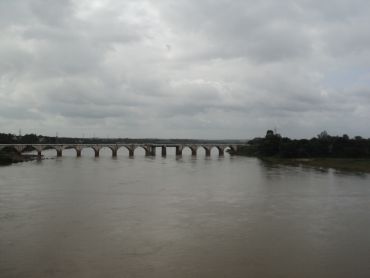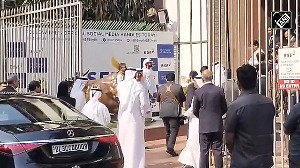 While the Cauvery issue has brought life in Karnataka to a standstill on Saturday, the tussle will continue before the Supreme Court on Monday with both Karnataka and Tamil Nadu battling it out, reports Vicky Nanjappa.
While the Cauvery issue has brought life in Karnataka to a standstill on Saturday, the tussle will continue before the Supreme Court on Monday with both Karnataka and Tamil Nadu battling it out, reports Vicky Nanjappa.
While a staggering Rs 60 crore has been spent on litigation alone by the two states, this appears to be a battle which will continue for a very long time. Both the state governments have been fighting it out every year in the apex court regarding the contentious issue and this year too is no different.
An RTI application, which had been filed a couple of years back, had indicated that until 2008 a sum of Rs 48.44 crore had been spent by both the states only on the legal battle. At that time the figures indicated that Karnataka had spent Rs 23.44 crore towards lawyer's fee while Tamil Nadu had coughed up Rs 25 crore.
The Cauvery battle has been fought in various courts and tribunals since the past 20 years. In these two decades while both states have lost a lot in terms of strikes, protests and bandhs, there has been a great deal of money that has been spent on litigation too. The RTI application and its orders indicated that the sum spent on the advocates included fees and hotel expenses which were borne by the amount generated by the state public works department.
This time around there are multiple petitions in the Supreme Court by both states and the battle is expected to be intense considering it has been a distress year in terms of rainfall.
The Cauvery River Waters Authority headed by Prime Minister Manmohan Singh had said in its order, "We are all aware that the arrival of monsoon was late in the country and many states have received less than expected rainfall. As on September 10, 2012, I am informed that the deficit rainfall in Tamil Nadu is 21 per cent while Karnataka has received 18 per cent less rainfall. I am also informed that Karnataka was in a position to sow only 74.7 per cent of its normal agriculture area, while Tamil Nadu could sow only 33.3 per cent of its normal agricultural area. In this situation, when both the states are in distress, it is natural to expect that this distress would be shared among the basin states. The existing reservoirs have to be so regulated that the requirements are optimally met in both the upper and lower riparian states."
During the arguments Karnataka had suggested that they are facing severe drought. Once the south west monsoon ends no significant inflows of water are expected till south west monsoon next year. A minimum storage of water is essential to provide drinking water to its cities, and for minimum irrigation needs, it has also stated.
Tamil Nadu, on the other hand, emphasised the grave water situation faced by it. It sought immediate release of water as per the terms of the award, and stated that water was essential if the samba crop in the state was to be saved. It wanted CRA to ensure that the water was released by Karnataka.
Pondicherry has also spoken on similar lines.
Finally the CRA concluded that Karnataka should release 9,000 cusecs of water daily from September 20 to October 15.
It has been releasing 10,000 cusecs daily from September 12, on the directions of the Supreme Court.
However, after this order both the states were unhappy and decided to knock the doors of the Supreme Court. While Tamil Nadu demanded that 2 TMC of water be released per day, Karnataka on the other hand told the apex court that the demand is unreasonable as it is a distress year.
Karnataka in its reply to Tamil Nadu before the Supreme Court stated that the accounting of the flows should take place at the end of December after an interim assessment at the end of September when the south-west monsoon is fairly known. It also stated that the Cauvery basin above the interstate border Biligundlu is 48.3 per cent as compared to the normal flows (average of 38 years from 1974-75 to 2011-12).
Tamil Nadu then filed another application on September 28 seeking a direction for higher flows than ordered by the CRA.
The Supreme Court ordered, "Karnataka is directed to release 9,000 cusecs of water daily till October 15, in terms of the decision taken by the chairperson, Cauvery River Authority in the seventh meeting of the said authority held on 19.09.2012."
The Supreme Court had also made a stinging remark against Karnataka stating that it should first obey the CRA order and then file its appeal.
Karnataka then decided to go before the Supreme Court challenging the order of the CRA. It states in its petition which is to be listed for orders on Monday that "consequent to the release of water from the reservoirs in Karnataka, the farmers in the districts of Mysore, Mandya and Hassan have taken to gherao and even threatened to seize the dam. Strong perceptions of the farmers are that any release from the reservoir would affect their standing crops which are their only livelihood. The widespread agitation protesting against the releases has badly affected the normal civic life in the cities and towns viz., Mysore, Mandya etc., but all possible steps to ensure law and order (so far not unsuccessful) have been and are being taken."
"The busiest highway between Bangalore-Mysore has been physically blocked by the agitators. The schools and colleges have closed. The peace committees have been formed in towns and cities. But the agitation is being kept under control by the government by deploying adequate security forces. However, the reaction of the people cannot be ignored as it has all the potential to go out of hands, despite best efforts to keep it under control," the petition adds.
"Karnataka's water requirements are about 140 TMC for irrigation to standing kharif and perennial crops under the systems dependent on four reservoirs and drinking water supplies in this water year from October onwards. But, the present storage as on 02.10.2012 is 67 TMC and the expected inflow should be 40 TMC (if the average of 38 years (1974-75 to 2011-12) is considered with 40 per cent reduction due to distress) taking the total available water in Karnataka to 107 TMC. Thus, the available total water of 107 TMC is far below the future requirement of 140 TMC in Karnataka for irrigation and drinking water supplies including supplies to Bangalore city with a population of 8.4 million. It is further submitted that the Kabini reservoir which contributes significantly to the releases at Biligundlu has suffered the most this water year as the shortfall is 55 per cent since only 43 TMC is the inflow as against an average inflow of the past 38 years (1974-75 to 2011-12) of 98 TMC," the petition notes.
"After the end of September, the assessment of the available flows and requirement is now fairly available. The CRA which met on 19.09.2012 had a truncated picture before it. The present available data till the end of September show that the requirements of Tamil Nadu can be fairly met without continuing the releases of 9,000 cusecs at the interstate border Biligundlu as ordered by the CRA," the petition adds.
"In 123 days between 01.10.2012 to 31.01.2013, which is the cropping period for samba rice crop in Tamil Nadu undisputedly, the requirement of water is 123 TMC, being 1 TMC per day on average," the petition also states.
Image: Cauvery river seen in Mysore
Photograph Courtesy: Wikimedia Commons








 © 2025
© 2025